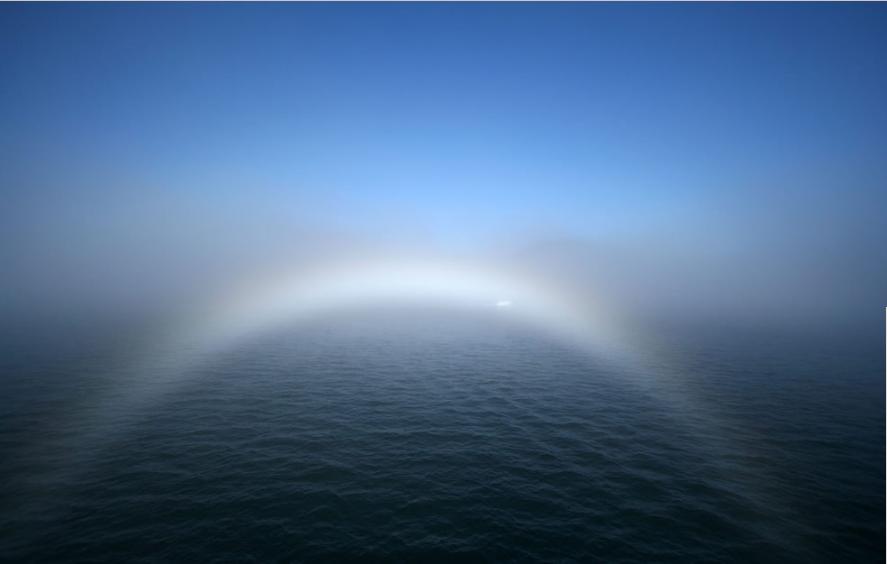Fogbow, Pacific Northwest
Fogbow, Pacific Northwest: A Spectacular Optical Phenomenon
Have you ever witnessed a foggy morning in the Pacific Northwest and noticed a peculiar sight in the sky? If so, you may have been lucky enough to witness a mesmerizing atmospheric optical phenomenon known as a fogbow. While similar to a rainbow, fogbows possess their own unique characteristics that make them a captivating sight to behold.
A fogbow is essentially a colorless or pale white arc that appears in the sky when sunlight interacts with tiny water droplets suspended in fog or mist. Unlike rainbows, which are formed by the refraction and reflection of sunlight through raindrops, fogbows are created by the diffraction of light around water droplets in foggy conditions. This causes the colors to blend together, resulting in a nearly colorless arc.
The Formation of Fogbows
To understand how fogbows form, we must first examine the conditions necessary for their creation. Fogbows require three key components: sunlight, fog or mist, and the presence of tiny water droplets. When sunlight passes through these droplets, it undergoes diffraction, which causes the light waves to bend and spread out. This bending of light results in the formation of a circular arc in the sky, with the observer positioned at its center.
The Unique Appearance of Fogbows
Unlike rainbows, which exhibit a vibrant display of colors, fogbows appear predominantly white or pale in color. This lack of vibrant hues is due to the diffraction process, which causes the light waves to overlap and cancel out certain colors. As a result, fogbows often appear as ethereal, colorless arcs against a backdrop of fog or mist.
One distinguishing feature of fogbows is their "supernumerary bows." These faint, additional arcs can sometimes be observed within the main fogbow. Supernumerary bows are caused by the interference of light waves as they diffract around the water droplets. These additional arcs may appear as faint bands of pastel colors, adding an extra touch of enchantment to the already captivating phenomenon.
Optimal Conditions for Viewing Fogbows
To witness a fogbow in all its glory, several factors must align. Firstly, there must be sufficient sunlight to illuminate the fog or mist. Bright, direct sunlight is ideal for creating a well-defined fogbow. Additionally, the fog or mist should be relatively thin, allowing for the passage of sunlight through the droplets. Finally, the observer must position themselves with the sun at their back and the fog or mist in front of them to observe the fogbow forming in the sky.
Fogbows in the Pacific Northwest
The Pacific Northwest is known for its frequent foggy conditions, making it an ideal region for observing fogbows. The combination of cool oceanic air and nearby mountain ranges creates a favorable environment for fog and mist to form. This, coupled with the region's abundant sunlight during certain times of the year, offers ample opportunities for residents and visitors alike to witness the ethereal beauty of fogbows.
Capturing the Magic of Fogbows
Photographing a fogbow can be a challenging yet rewarding endeavor. Due to their pale coloration and subtle appearance, fogbows can be difficult to capture on camera. However, with the right equipment and techniques, it is possible to immortalize these captivating optical phenomena. To enhance the visibility of a fogbow in photographs, it is advisable to use a polarizing filter or adjust camera settings to increase contrast.
In conclusion, fogbows are a remarkable atmospheric optical phenomenon that adds a touch of enchantment to foggy mornings in the Pacific Northwest. These ethereal, nearly colorless arcs are formed through the diffraction of sunlight around tiny water droplets suspended in fog or mist. While less vibrant than rainbows, fogbows possess their own unique beauty, with the occasional appearance of supernatural bows adding an extra touch of wonder. So, keep your eyes peeled on foggy days in the Pacific Northwest, as you might just catch a glimpse of this mesmerizing natural spectacle.

Imaged by Manuel Wanskasmith (images) on a ferry boat in the Pacific Northwest. On the otherwise sunny morning the ferry passed into a fogbank. Fogbows need bright sunlight shining on a thin layer of mist or fog. Image ©Manuel Wanskasmith.
Note: this article has been automatically converted from the old site and may not appear as intended. You can find the original article here.
Reference Atmospheric Optics
If you use any of the definitions, information, or data presented on Atmospheric Optics, please copy the link or reference below to properly credit us as the reference source. Thank you!
-
<a href="https://atoptics.co.uk/blog/fogbow-pacific-northwest/">Fogbow, Pacific Northwest</a>
-
"Fogbow, Pacific Northwest". Atmospheric Optics. Accessed on April 19, 2024. https://atoptics.co.uk/blog/fogbow-pacific-northwest/.
-
"Fogbow, Pacific Northwest". Atmospheric Optics, https://atoptics.co.uk/blog/fogbow-pacific-northwest/. Accessed 19 April, 2024
-
Fogbow, Pacific Northwest. Atmospheric Optics. Retrieved from https://atoptics.co.uk/blog/fogbow-pacific-northwest/.